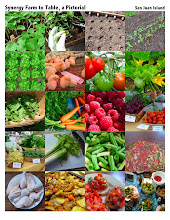
The green bean glut is on!
After the harvest on Friday, we knew we had more beans than we could possibly sell or eat at once, so Saturday evening, spurred by the abundance, we undertook our first canning project of the season.
As amateur canners, we carefully consulted and stuck to the recommendations of Nancy Chioffi and Gretchen Mead's book Keeping the Harvest. Their recipe for dilly beans and general processing instructions were easy to follow, and we only needed a few special tools:
- pint-jars
- new pint lids
- large pot
- makeshift canning rack to keep the jars off the bottom during processing (we used the rings off old canning lids)
- jar lifter (available at the grocery store)
We haven't opened a jar to try them yet, but the process seemed like a success. Do you have a favorite bean canning recipe? We'd love to hear about it!
from Keeping the Harvest by Nancy Chioffi and Gretchen Mead
2 lbs green and yellow wax beans, trimmed
1 tsp cayenne pepper
4 cloves garlic
4 heads dill
2 1/2 cups water
2 1/2 cups vinegar
1/4 cup canning salt
Pack beans, lengthwise, into hot pint jars, leaving 1/2 inch headroom. The jars shouldn't end up too full -- leave enough room for vinegar solution to flow between beans. To each pint, add 1/4 tsp cayenne pepper, 1 clover garlic, and 1 head dill. Combine remaining ingredients and bring to a boil. Pour boiling hot water over beans, leaving 1/4 inch headroom. Adjust caps. Process pints 10 minutes in boiling water bath (10 minutes from the point when water is boiling vigorously). Yield: 4 pints.
For best flavor let the canned beans stand for at least two weeks before serving. This allows the flavor to develop. And don't worry if they look shrivelled right after processing. They'll plump up in 4-6 weeks.
 Beans packed in the pint jars, topped with a garlic clove, a dill-head, and 1/4 tsp of cayenne pepper
Beans packed in the pint jars, topped with a garlic clove, a dill-head, and 1/4 tsp of cayenne pepper Once the jars are filled with the hot vinegar solution (leaving 1/4'' headroom), we wiped the tops of the jars with a dry paper towel to remove any moisture that might inhibit the seal. Then we put on the tops and screwed on the rings.
Once the jars are filled with the hot vinegar solution (leaving 1/4'' headroom), we wiped the tops of the jars with a dry paper towel to remove any moisture that might inhibit the seal. Then we put on the tops and screwed on the rings. The jars were added to a pre-heated pot of water, positioned atop our makeshift can rack, made of old canning lid rings. It's important to use a rack and to make sure the jars don't touch each other or the sides of the pot in order to ensure an even temperature around the jar during processing. Once the water came to a boil, we processed for 10 minutes.
The jars were added to a pre-heated pot of water, positioned atop our makeshift can rack, made of old canning lid rings. It's important to use a rack and to make sure the jars don't touch each other or the sides of the pot in order to ensure an even temperature around the jar during processing. Once the water came to a boil, we processed for 10 minutes.  We lifted out the jars with our handy jar-lifter and put them in a draft-free place to cool for 12 hours.
We lifted out the jars with our handy jar-lifter and put them in a draft-free place to cool for 12 hours.




No comments:
Post a Comment